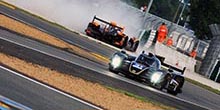LE MANS, France — Today when we hear the name “Patriot” used in the context of the automotive world we think of the newly released Chrysler Jeep product. But in the early to mid 1990s it was a Chrysler race car that was designed to go Le Mans and compete for the prestige that comes with winning the 24 Hours of Le Mans. The Patriot was not only a car that was designed to go Le Mans but it was also a hybrid design that unfortunately never saw the track in anger.
The brain-child of Francois J. Castaing, who had been brought to Chrysler from Renault to change the way the company thought about car design. He was more successful on that tact than getting the Patriot off the ground — or should we sat to the race track. Castaing, who became the vice-president of vehicle engineering at Chrysler and was the brainchild behind the successful Chrysler LH series of cars (Intrepid, Concorde, Vision, LHS, New Yorker) was well ahead of his time with the Patriot.
Built on a standard race chassis of the day from the now defunct Raynard chassis builder for the then World Sports Car (WSC) class. But the chassis was about all that was even close to standard as the car was suppose to have a have a “generation station” built into it that would use a natural gas turbine to drive a pair of alternators to which would power a 525 V AC induction motor.
While today battery technology is one of the limiting factors (or at the very least bottlenecks) in a truly successful electric vehicle, in the mid 1990s there was not way to store this energy efficiently. So Chrysler engineers turned to the flywheel. The team at Auburn Hills looked to the flywheel to provide the “oomph” needed to drive the car out of the corners with short bursts of acceleration.
This flywheel system was designed to turn at 58,000 rpm in a vacuum housing made of carbon fiber. However, in dyno testing of the system two full-tilt implosions of the flywheel put a halt to development of the project. Engineers did not think that they could easily protect the driver in the event of an flywheel failure and that was the end of this dream.
The Patriot never did run with full drive-train and while there are photos of the car on the track these were made by towing the car on the track and then retouching these photos to remove the tow rope.
Castain is quoted as saying,”We’ve learned a lot about hybrid technology and that we are stopping doesn’t mean we failed.”
A very complete view of the project with pictures and more details is found here.



Post a reply